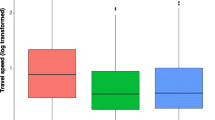Abstract
The home range and ranging pattern of the slender loris (Loris tardigradus lydekkerianus) was studied for 21 months in a scrub jungle in Dindigul, Tamil Nadu, south India. Sixteen individuals were observed for a total of 2261 hours. Home ranges were measured for eight adult individuals and eight juvenile and subadult individuals. Males had significantly larger home ranges than the females, and home range size increased post-weaning. The ranging patterns involved minimal female intrasexual overlap, large male intrasexual overlap and large intersexual range overlap.
Similar content being viewed by others
References
Altmann, J. 1974. Observational study of behaviour: sampling methods.Behaviour, 49: 227–267.
Anonymous. 1981.Techniques for the Study of Primate Population Ecology. National Academy Press, Washington D.C.
Bearder, S. K. 1987. Lorises, bushbabies, and tarsiers: diverse societies in solitary foragers. In:Primate Societies,Smuts,B. B.;Cheney,D. L.;Seyfarth,R. M.;Wrangham,R. W.;Struhsaker,T. T. (eds.), Univ. of Chicago Press, Chicago, pp. 11–24.
Charles-Dominique, P. 1977.Ecology and Behaviour of Nocturnal Primates. Duckworth, London.
Charles-Dominique, P.;Bearder, S. K. 1979. Field studies of lorisoid behavior: methodological aspects. In:The Study of Prosimian Behavior,Doyle,G. A.;Martin,R. D. (eds.), Academic Press, New York, pp. 567–629.
Emlen, S. T.;Oring, L. W. 1977. Ecology, sexual selection and the evolution of mating systems.Science, 197: 215–223.
IUCN. 2000.2000 IUCN Red Data List of Threatened Animals. IUCN-The World Conservation Union, Gland.
Johnson, J. M. 1984. Diurnal activities of the slender loris,Loris tardigradus, in the Mundanthurai Sanctuary, Tamil Nadu (India). In:Current Primate Researches,Roonwal,M. L.;Rathore,N. S. (eds.), Jodhpur Univ. Press, Jodhpur, pp. 441–447.
KarGupta, K.; Nash, L. T. 2001. Large testes and pair bonds: How does the slender loris mate? In:Abstracts and Programme, XVIII Congress of the International Primatological Society, Int. Primatol. Society, Australasian Primatol. Society, Adelaide Zoo & EventsOz Conference Organisers, p. 156.
Nekaris, K. A. I. 2000. The socioecology of the Mysore slender loris (Loris tardigradus lydekkerianus) in Dindigul, Tamil Nadu, South India. Ph.D. thesis, Washington Univ., St Louis.
Petter, J. J.;Hladik, C. M. 1970. Observations on the home range and population density ofLoris tardigradus in the forests of Ceylon.Mammalia, 34: 394–409.
Radhakrishna, S. 2001. Reproductive and social behaviour of slender loris (Loris tardigradus lydekkerianus) in its natural habitat. Ph.D. thesis, Mysore Univ., Mysore, India.
Roonwal, M. L.;Mohnot, S. M. 1977.Primates of South Asia: Ecology, Sociobiology and Behavior. Harvard Univ. Press, London.
Sarkar, D. H. B.;Murali, S.;Prasad, D. T.;Shekarappa, B. M.;Vijayalakshmi, V. 1981. The population and distribution of the slender loris,Loris tardigradus, in Karnataka state.Tigerpaper, 8: 7–10.
Schulze, H.;Meier, B. 1995. The subspecies ofLoris tardigradus and their conservation status: a review. In:Creatures of the Dark: The Nocturnal Prosimians,Alterman,L.;Doyle,G. A.;Izard,M. K. (eds.), Plenum, New York, pp. 193–209.
Singh, M.;Kumar, M. A.;Kumara, H. N.;Mohnot, S. M. 2000. Distribution and conservation of slender lorises (Loris tardigradus lydekkerianus) in southern Andhra Pradesh, south India.Int. J. Primatol., 21: 721–730.
Singh, M.;Lindburg, D. G.;Udhayan, A.;Kumar, M. A.;Kumara, H. N. 1999. Status survey of slender lorisLoris tardigradus lydekkerianus in Dindigul, Tamil Nadu, India.Oryx, 33: 31–37.
Sokal, R. R.;Rohlf, F. J. 1995.Biometry: The Principles and Practice of Statistics in Biological Research. Freeman, New York.
Sterling, E. J. 1993. Patterns and range use and social organization in aye-ayes (Daubentonia madagascariensis) on Nosy Mangabe. In:Lemur Social Systems and Their Ecological Basis,Kappeler,P. M.;Ganzhorn,J. U. (eds.), Plenum, New York, pp. 1–10.
Author information
Authors and Affiliations
About this article
Cite this article
Radhakrishna, S., Singh, M. Home range and ranging pattern in the slender loris (Loris tardigradus lydekkerianus). Primates 43, 237–248 (2002). https://doi.org/10.1007/BF02629651
Received:
Accepted:
Issue Date:
DOI: https://doi.org/10.1007/BF02629651



